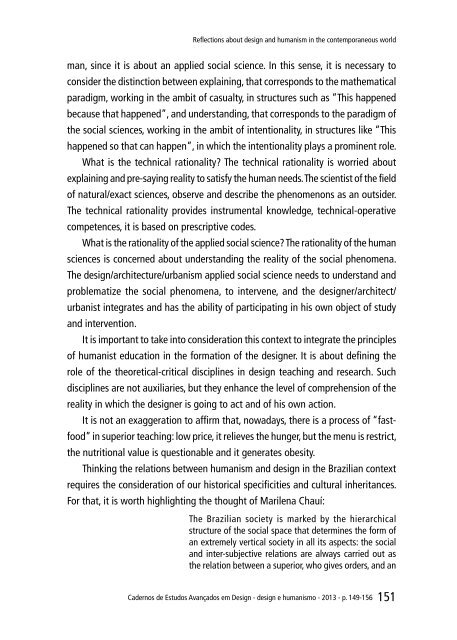o_19po8js951tvs1r0t1r8s4bb1vpla.pdf
Create successful ePaper yourself
Turn your PDF publications into a flip-book with our unique Google optimized e-Paper software.
Reflections about design and humanism in the contemporaneous world<br />
man, since it is about an applied social science. In this sense, it is necessary to<br />
consider the distinction between explaining, that corresponds to the mathematical<br />
paradigm, working in the ambit of casualty, in structures such as “This happened<br />
because that happened”, and understanding, that corresponds to the paradigm of<br />
the social sciences, working in the ambit of intentionality, in structures like “This<br />
happened so that can happen”, in which the intentionality plays a prominent role.<br />
What is the technical rationality? The technical rationality is worried about<br />
explaining and pre-saying reality to satisfy the human needs. The scientist of the field<br />
of natural/exact sciences, observe and describe the phenomenons as an outsider.<br />
The technical rationality provides instrumental knowledge, technical-operative<br />
competences, it is based on prescriptive codes.<br />
What is the rationality of the applied social science? The rationality of the human<br />
sciences is concerned about understanding the reality of the social phenomena.<br />
The design/architecture/urbanism applied social science needs to understand and<br />
problematize the social phenomena, to intervene, and the designer/architect/<br />
urbanist integrates and has the ability of participating in his own object of study<br />
and intervention.<br />
It is important to take into consideration this context to integrate the principles<br />
of humanist education in the formation of the designer. It is about defining the<br />
role of the theoretical-critical disciplines in design teaching and research. Such<br />
disciplines are not auxiliaries, but they enhance the level of comprehension of the<br />
reality in which the designer is going to act and of his own action.<br />
It is not an exaggeration to affirm that, nowadays, there is a process of “fastfood”<br />
in superior teaching: low price, it relieves the hunger, but the menu is restrict,<br />
the nutritional value is questionable and it generates obesity.<br />
Thinking the relations between humanism and design in the Brazilian context<br />
requires the consideration of our historical specificities and cultural inheritances.<br />
For that, it is worth highlighting the thought of Marilena Chauí:<br />
The Brazilian society is marked by the hierarchical<br />
structure of the social space that determines the form of<br />
an extremely vertical society in all its aspects: the social<br />
and inter-subjective relations are always carried out as<br />
the relation between a superior, who gives orders, and an<br />
Cadernos de Estudos Avançados em Design - design e humanismo - 2013 - p. 149-156<br />
151



